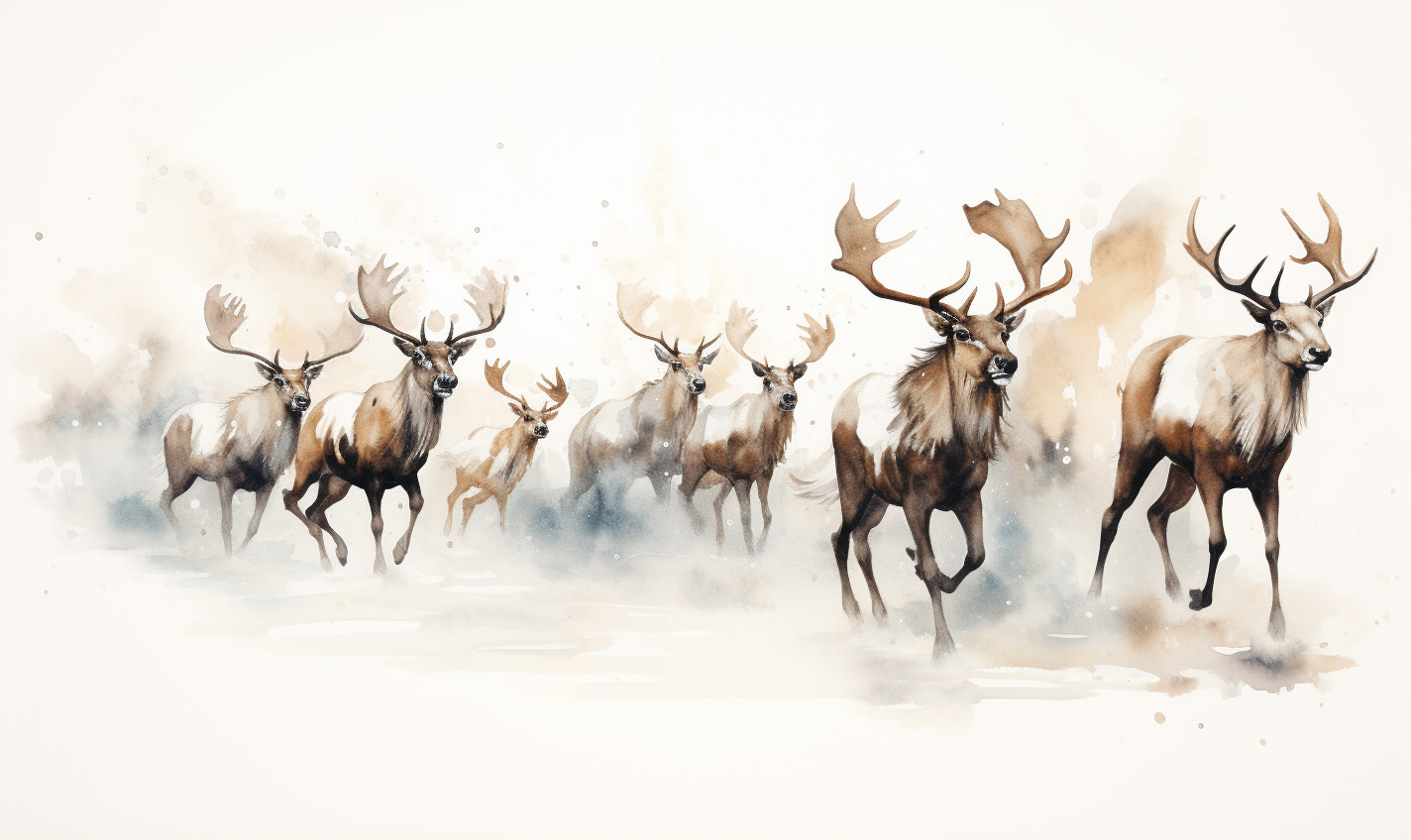This page may contain affiliate links.
Read our disclosure and privacy policy here.
Each year, the caribou of North America set out on an incredible journey, trekking thousands of miles in search of food and safe breeding grounds. Their migrationMigration is the regular movement of animals from one place to another, often to find food or better weather. It’s a seasonal trip that many animals take for survival. Learn More, one of the longest by any land animal, is a captivating tale of struggle, challenge, and perseverance against the elements. They face harsh weather conditions, predators, and other hurdles. Dive in to discover the fascinating details behind this annual challenge and find out what keeps these caribou on the move.
Table of Contents
The Caribou Migration: An Iconic Journey Across The Arctic Tundra
Video Documentary
Checkout this cool documentary we produced on the iconic migration of the caribou, aka reindeer!
Why Do Caribou Migrate?
Caribou are nomadic“Nomadic” in terms of animals means they don’t have a fixed home. Instead of staying in one place, these animals move around a lot, often in search of food or better living conditions. It’s like if you went camping in different places all the time instead of living in just one house. Learn More; they’re always on the move. But they don’t just wander around aimlessly. They have specific reasons for their migration:
Food Hunt
Just like we might travel to a grocery store when we’re hungry, caribou travel, but their journey is a bit more challenging. They move to find food. During summer, the Arctic tundraThe tundra is a cold, windy, and often snowy biome found in the far northern parts of the Earth, like in Alaska, Canada, and Siberia. It’s a place where the soil is mostly frozen, and you won’t find any tall trees, just low-growing plants like mosses and shrubs. Even though it’s super chilly, animals like polar bears, arctic foxes, and caribou still call it home! Learn More bursts with grasses, flowers, and other plants. But as winter approaches, these plants become scarce. To find enough food, caribou head to areas with more abundant lichensLichen is a unique life form made up of two different organisms living together: a fungus and an alga or bacterium. They grow on rocks, trees, and even in harsh environments like deserts and the Arctic. The fungus gives structure while the alga or bacterium makes food through photosynthesis, so they help each other out! Learn More, which grow on the ground and can be found even under the snow.
Safety for Babies
Female caribou need a safe place to give birth to their calves, away from most predators. So, in spring, they lead the way to special calving grounds which offer some protection. After giving birth, and once the calves are strong enough, they’ll start the journey back to their winter feeding grounds.
Avoiding Predators
Traveling in large groups makes it harder for predators, like wolves, to pick out a single caribou. It’s like blending into a crowd, making them less of a target.
Changing Climate
As seasons change, so does the weather. Caribou prefer cooler temperatures. When it gets warmer in summer, they move to cooler places and return when it gets colder.
The Dangers and Challenges of Caribou Migration
Caribou face numerous dangers during their migration. Predators such as wolves and bears pose significant threats, especially to young calves. The journey itself is arduous, often spanning hundreds of miles, and the caribou must navigate rough terrains, rivers, and ever-changing weather conditions. In recent years, human disturbances like roads, infrastructure, and mining have posed additional challenges, altering migration routes and sometimes leading to increased mortalityMortality means the rate at which creatures die in a certain place or during a specific time. It’s a way to measure how risky or safe an environment is for animals or people. For example, if many baby turtles don’t make it to the ocean, the mortality rate for that group would be high. Learn More.
Predator Attacks During Migration
Caribou have to watch out for quite a few animals that see them as a tasty meal. The most challenging predator they face? Wolves. Wolves travel in groups called packs and can chase down and catch even the fastest adult caribou. Besides wolves, bears (both black and grizzly types) sometimes go after young caribou or those who look sick or weak. And here’s a surprising fact: Golden eagles, which are huge birds, can sometimes swoop down and grab caribou calves!
But caribou aren’t just waiting around to become someone’s dinner. They’ve got a few tricks up their hooves! One smart thing they do is stick together in large groups, called herds. Being in a big group makes it tricky for predators to pick out a single caribou to chase. Caribou also travel long distances, a journey known as migration, to places where fewer hungry animals are waiting. They’ve even got special spots, called calving grounds, where they give birth to their babies, keeping them safe from predators.
However, humans are making life a bit harder for caribou. Things like roads and buildings can split up their habitats, making them more exposed to dangers. So, while nature has its challenges, it’s also important to remember the impact we have on these incredible animals.
Harsh Weather
The areas caribou migrate through can have extreme weather. They face blizzards, icy conditions, and freezing temperatures. These can make it hard for them to find food or can make their journey more exhausting.
River Crossings
Part of the caribou’s migration includes crossing large, cold rivers. The water is freezing, and the currents can be strong. Some caribou, especially the younger ones, can get swept away or struggle to reach the other side.
Human-made Obstacles
Roads, fences, and pipelines can block the caribou’s traditional paths. These obstacles can make it hard for them to access their usual feeding grounds or can force them into areas where they’re more exposed to predators.
Food Shortages
The caribou are always in search of food. But sometimes, due to various reasons like weather or changes in the environment, their favorite foods aren’t available. This means they have to travel even more to find enough food to eat.
Tiring Journey
The sheer distance and the challenges along the way can wear the caribou out. It’s a long trip, and they have to keep up their strength and energy while facing all these challenges.
Survival During The Caribou Migration
Their sheer numbers help in survival. Caribou often move in large herds, which can deter some predators. Additionally, their hooves are adapted for various terrains – broad and tough for snow and marshy grounds, and sharp-edged for digging through snow in search of food.
Large Hooves
Caribou have wide, concave hooves. These serve multiple purposes. In the snow, they act like snowshoes, helping caribou walk without sinking. When crossing marshy grounds or rivers, they act as paddles. These hooves also come in handy when digging through the snow to find lichen, their primary food source.
Thick Fur
Caribou have a specialized coat with two layers of fur – a dense, woolly underlayer and a longer, hollow outer layer. This combination insulates them from the cold temperatures and helps keep them buoyant in the water.
Migrating in Groups
There’s safety in numbers. When caribou travel in large groups, it can be more challenging for predators to single out an individual. Also, many eyes and ears are better for detecting threats.
Strong Senses
Caribou have a keen sense of smell, which helps them locate lichen buried under the snow. Their sharp hearing also alerts them to potential dangers.
Seasonal Diet Changes
While lichen is their main winter food, in the warmer months, caribou diversify their diet, consuming a variety of plants, grasses, and even mushrooms. This varied diet helps them build up reserves for the harsher winter months.
Stamina
Caribou are built for endurance rather than speed. They can travel vast distances at a steady pace, conserving energy and covering significant ground daily.
Rapid Muscle Recovery
Research has shown that caribou muscles recover quickly from fatigue, thanks to a rich supply of blood to their muscles, allowing them to travel long distances day after day.
Flexibility in Migration Routes
While they follow general patterns, caribou can adjust their routes based on food availability, weather conditions, and potential threats.
Intuition and Memory
Over generations, caribou have developed instincts about where to go, driven by their need for food, mating, or calving. They also remember locations from year to year, including where they might find food or face danger.
The Caribou Migration Is An Iconic Journay
The caribou’s migration is one of the great spectacles of the animal kingdom, demonstrating their adaptability and endurance. Covering vast distances in search of food and suitable calving grounds, these creatures face numerous challenges, from predators to harsh weather conditions. But with their keen senses, strong herd instincts, and physical adaptations, they’ve been able to survive and thrive for generations. The continued existence of this migration underscores the importance of preserving the habitats and pathways vital to the caribou’s journey.

DISCUSSION
DISCUSSION
DISCUSSION
FOLLOW-UP TOPICS
Science Topics
Why Do Caribou Migrate?
- Initiation: Set the scene by having a map showing the vast Arctic region. Point out the vast distances and ask, “If you had to walk across this entire map, what reasons might make you take such a long journey?”
- Discussion Prompts: “What happens to the food caribou like in the winter?” “Why might it be safer for caribou to give birth away from where they eat during winter?”
- Learning Objective: Understand the primary reasons for migration – food scarcity and the need for safe birthing grounds.
Challenges of Migration
- Initiation: Show a short clip or images of harsh Arctic conditions – deep snow, fast rivers, and predators like wolves. Ask, “How might these challenges affect caribou during their journey?”
- Discussion Prompts: “How do you prepare for a difficult journey or task?” “How might a caribou’s long legs or hooves help it during migration?”
- Learning Objective: Gain empathy and insight into the physical challenges of migration and the adaptations that help caribou overcome them.
Human Impact on Caribou Migration
- Initiation: Start with a storytelling approach. “Imagine caribou as characters in a story. Every year they take the same path, but one year they find a big road or a noisy construction site in their way.”
- Discussion Prompts: “How would our caribou characters feel? What choices would they have to make?”
- Learning Objective: Reflect on how human activities can disrupt natural processes and the importance of sustainable development.

There’s a lot to explore right where we are, in our own neighborhoods and backyards! Join us while we get off the couch and explore the everyday wonders of nature, science, space, engineering, art, and anything else we stumble upon during on our adventures.



